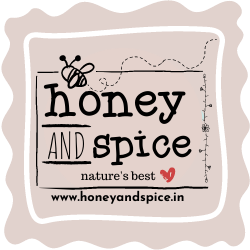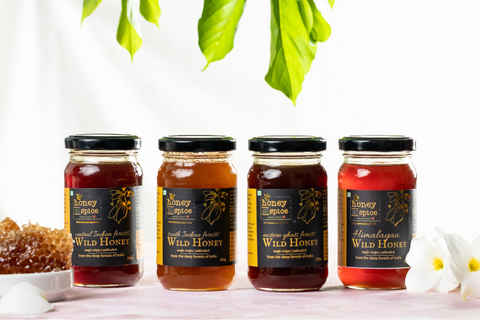With the different types of honey available in the market, there’s a high chance you have never tasted real honey! Most of the jars on the shelf are adulterated, heated, or pasteurized.
Sadly, no one knows about the truest form of honey- wild honey. So here you go!
What is Wild Honey?
Wild honey is a type of honey produced by bees by collecting nectar from natural habitats, such as wild forests, jungles, and mountain flowers. These bees travel naturally across the wild and produce honey without human intervention.

In contrast, the regular market honey comes from honeybees in managed hives set up by beekeepers. Such environments are conducive to feeding sugar syrup while the bee produces honey, leading to diluted honey production.
A. How does Wild Honey Taste?
Wild honey's taste is a delightful adventure for your taste buds, unlike the consistent flavor of store-bought honey.
Here's what you can expect:
#1: Variety
Since wild bees collect nectar from a diverse range of wildflowers and plants, the flavor profile of wild honey can vary greatly. Imagine notes of clover, wildflowers, mountain berries, or even hints of citrus, depending on the floral source.
#2: Uniqueness
Every jar of wild honey becomes a unique experience. You might encounter honey with a subtle sweetness and floral aroma, while another jar could surprise you with a more robust, earthy flavor.
For example, our Himalayan Wild Honey tastes sweet and woody with a waxy flavour but our South Indian Wild Honey is sweet, fruity and light with a tinge of sourness.
B. What does Wild Honey Look Like?
The texture of wild honey can also be quite varied compared to commercially produced honey.

#1: Generally Thicker
Wild honey tends to be thicker and denser than cultured honey. This is because it's often unprocessed and hasn't undergone filtering or heating processes that can thin it out.
#2: Possible Crystallization
Due to its rawness and lack of processing, wild honey is more prone to crystallization based on its moisture level. This doesn't mean it's gone bad; it just means it’s pure.
#3: Natural Content
Unlike filtered cultured honey, wild honey might contain tiny pollen grains and even trace amounts of beeswax. This leads to a thicker consistency of honey.
Note: The texture might slightly vary based on where the wild honey comes from.
For example, our Himalayan Wild Honey is thicker than our Wild Acacia honey- as a result of different regional flowers and seasonality.
C. What Colour Does Wild Honey Come In?
The color of wild honey is just another exciting aspect of its natural variation! Unlike the uniform golden color of commercially produced honey, wild honey can range across a beautiful spectrum:

#1: Light Colors
If the bees fed primarily from light-colored flowers like clover or wildflowers, the honey might be a pale yellow or even a light amber. For example, our Wild Acacia Honey is light, and oil-like in colour.
#2: Golden Hues
This is a common color for wild honey, reflecting a mix of floral sources. A classic example is our South Indian Wild Honey.
#3: Darker Shades
If the bees collected nectar from darker-colored flowers or plants, the honey can range from a deep amber to a rich, almost reddish brown. Most customers associate this colour with our Himalayan Wild Honey.
Take a look at our diverse Wild Honey range and choose as per your liking!
Honey connoisseurs call wild honey “nature’s liquid gold” since it is the best form of honey, with all the benefits intact!
Let’s look at what these wild honey benefits are.
Wild Honey Benefits
Wild honey is unheated and unpasteurized, retaining all the natural goodness – pollen, propolis (resin bees use to build their hives), and even trace amounts of beeswax.
While these might seem like impurities, they actually contribute to the potential health benefits.
Pollen is a great source of vitamin C, vitamin B2, B3, B5 and B6, calcium, iron, potassium, magnesium, and zinc. All of which is vital for the body. While propolis is known for its antioxidant and anti-inflammatory properties.
The best wild honey in India contains bee pollen, which looks like specks but offers a health punch.
Packed with antioxidants, it protects cells from damage and may help prevent diseases. Bee pollen itself has anti-inflammatory and pain-relieving properties, potentially aiding wound healing and recovery.
Now that you understand the wild honey benefits, let’s see what will happen if you consume it daily.
What will happen if I consume Wild Honey regularly?

Wild honey isn't just a delicious sweetener; it can also benefit your health in a few ways.
Here's a quick look:
#1: Fights Cell Damage
Wild honey is rich in antioxidants. These act like bodyguards, protecting your cells from damage caused by free radicals (think of them as tiny troublemakers).
#2: Natural Energy Source
Feeling sluggish? Wild honey has natural sugars that can give you a quick energy boost, without the crash you get from sugary drinks.
#3: Possible Soother for Sore Throats and Fungus
Studies by US National Library of Medicine suggest wild honey might have antibacterial and antifungal properties. This means it could potentially soothe a sore throat or even help fight off fungal infections.
#4: Help Wounds Heal
Early research suggests the antibacterial properties in wild honey might also help wounds heal faster. Think of it as a potential natural bandage.
#5: Alternative to Refined Sugar
If you’re looking to quit unhealthy refined sugar, wild honey makes for a great sweetener without the health damage
#6: Natural Laxative
A spoonful of wild honey before sleeping or just when you wake up can help with improve indigestion and gas problems
#7: Dehydration Solution
Beyond giving you a quick energy lift, wild honey helps fight dehydration and weakness caused by a lack of essential nutrients in your diet.
We’ve covered the wild honey benefits but that’s half the information.
As a conscious platform, we are also responsible to shed light on any outlying side-effects of consuming too much wild honey.
Wild Honey Side Effects
Let’s quickly cover some rare but important wild honey side effects.
#1: Botulism in Infants
Wild honey, like all raw honey, might contain botulism spores. Harmless for adults, these spores can be dangerous for infants under 1. Keep wild honey away from babies to avoid serious illness.
#2: Allergies
Be aware of potential honey or bee pollen allergies, sometimes found in wild honey. Reactions can range from mild to severe. Seek immediate medical attention if you experience any symptoms.
#3: Sugar Content
Although natural, wild honey still contains sugar. Consuming too much sugar can contribute to weight gain, blood sugar issues, and other health problems. Enjoy wild honey in moderation.
#4: Potential for Stomach Issues
In some cases, consuming large amounts of wild honey can lead to digestive discomfort like bloating, gas, or diarrhea. This is especially one of the wild honey side effects for people with sensitive stomachs.
So, asking the real question…
Is wild honey safe?
The biggest benefit is that wild honey is generally safe and even offers health benefits due to its antioxidant content and potential antibacterial properties.
Adults can enjoy wild honey in moderation as a natural sweetener or for its potential health benefits. You don’t have to ask again “Is wild honey safe”?
The short answer to “Is wild honey safe?: YES!
If wild honey is so good, is it better than cultured honey too?
Which is better wild or cultured honey
Cultured honey is the regular honey we referred to at the beginning of this blog.
It undergoes refining and pasteurization before bottling. Wild honey retains the original, healthy properties of honey and emerges as the winner in comparison.
Here’s a simple table for you to understand which is better wild or cultured honey
| Feature | Wild Honey | Cultured Honey |
| Origin | Produced by bees in natural habitats | Produced by bees in managed hives |
| Floral Source | Diverse wildflowers and plants | Often a single flower type for controlled flavor |
| Flavor | Unique and varied flavors due to diverse floral sources | More consistent, but potentially less complex flavor |
| Processing | Raw and unfiltered | Often pasteurized and filtered |
| Potential Health Benefits | Has higher antioxidant content, potential antibacterial properties, contains pollen & propolis with potential health benefits | Lower levels of antioxidants & beneficial compounds due to processing, lack of pollen & propolis |
| Availability & Cost | Less common, more expensive | Widely available, affordable |
| Sustainability | Supports wild bee populations | Doesn't directly contribute to wild bee populations |
If you’ve fully understood which is better wild or cultured honey, your choice is clear. Instead of switching to another tab to find wild honey, keep scrolling.
Refer to the list below:
Where can I find wild honey?
Finding wild honey can be a bit of a treasure hunt, but here are some places you can look:
#1: Flea Markets/Pop-ups
Many flea markets support local beekeepers who might harvest and sell wild honey. Look for vendors with labels mentioning "wildflower honey" or "raw, unfiltered honey."
#2: Specialty Food Stores
Gourmet grocery stores (like Organic World or Nature’s Basket) specialize in natural and organic products that might carry wild honey.
#3: Online Retailers
Several online retailers offer wild honey but be cautious. Look for reputable vendors with a trustworthy supply chain and positive customer reviews.
For example, Honey and Spice harvests in a sustainable way from wild beehives by tribal partners, trained by WWF and other organizations. Our cruelty-free harvesting harms no honey bees or their hives.
We neither add nor remove anything from the honey that's made by the bees.
Feel free to check us out here.
Tips for Finding High-Quality Wild Honey
#1: Ask Questions
Don't hesitate to ask the seller about the honey's origin, harvesting methods, and processing. Look for vendors who can answer your questions confidently.
#2: Check Labels
Reputable wild honey labels will often mention the region where it was harvested and might specify the types of wildflowers the bees foraged from.
#3: Price Point
While wild honey can be expensive, an extremely low price might be a red flag.
#4: Appearance
As you already know, wild honey varies in color and texture depending on the floral source. Anyone who sells wild honey in the same colour for years is likely involved in adulteration.
Here is a Wild Honey Label where you can get all this information so you are sure before buying.
A Quick Summary
Wild honey- the golden nectar, unlike store-bought honey, comes from bees buzzing freely in nature, collecting nectar from a diverse range of wildflowers.Packed with antioxidants and potential antibacterial properties, wild honey offers a symphony of flavors and a treasure trove of health benefits.
It might boost your energy, soothe a sore throat, or even aid wound healing (research is ongoing).
If you’re interested to know more about the types of honey and how to choose, discover The Best Wild Honey in our exclusive selection.







